Virtual reality in ecommerce is the new power for conversion.
Suppose a user visits your ecommerce app or online shopping store. After exploring few product pages, the user leaves the platform without making a purchase.
If your ecommerce app is also facing this conversion problem, you are not alone.
According to the latest market reports, the average conversion rate in the ecommerce market decreased by 0.91% from 1.65% to 1.64% in February 2023 as compared to the previous year. (FY 2022)
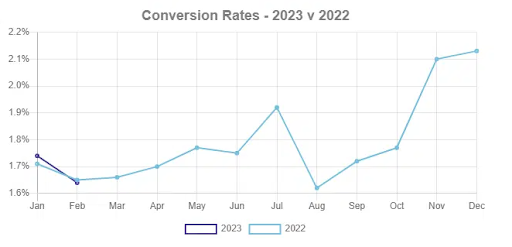
And one of the major reasons behind this downfall in ecommerce conversion rate is higher product returns and increased user expectations due to technology advancements.
Today, users look for smart and engaging ways to explore products and shop online. As new innovations and trends are emerging the need for providing an effective online shopping experience has become crucial for converting visitors into customers.
Here, Virtual Reality technology stands out as the best solution that could help you not only improve the conversion ratio but also deliver a new-age online shopping experience to your customers.
VR technology empowers ecommerce with highly interactive and 3D immersive features. By implementing virtual reality in ecommerce you get the power to influence their buying decision and convert them into customers.
But again, the question arises how does Virtual Reality help increase the conversion ratio of e-commerce?
In this blog, we will explain the role and benefits of using VR in ecommerce. If you run online shopping store or ecommerce website or planning to launch your own ecommerce application, this blog will guide you on why you should adopt VR in your ecommerce app.
So let’s dive into
Table of Contents
What is VR?
Virtual reality (VR) is an immersive technology that creates computer-generated virtual graphics or immersive experiences like real-world scenarios. It allows users to simulate real-world environments in a virtual or digital way.
VR creates a world around you, not just in front of you. It’s like putting on a pair of magical goggles that transport you to another place. You can see it in stunning detail, and hear the sounds all around you. And sometimes even feel things like the wind or the texture of an object.
How Does Virtual Reality Work in eCommerce?
Virtual reality in ecommerce works in various ways. It primarily empowers ecommerce apps with immersive features to enhance the online shopping experience. Integrating VR in custom mobile app development or other solutions enables the application to simulate virtual environments like real-world physical objects.
With VR features in ecommerce apps users can interact with products & services in real-time virtually in a highly realistic and immersive manner. So, virtual reality works in several different ways allowing ecommerce applications with advanced capabilities. VR helps in making the user journey and online buying experience more engaging and interactive. Here is how.
Virtual Reality Shop: Unlike a traditional 2D eCommerce website or mobile app, it is a 3D Virtual ecommerce store that mimics a physical store. It allows customers to browse products or services in an interactive way.
Virtual Try-Before-You-Buy: In conventional ecommerce platforms customers don’t get the facility to try your products online. But with VR users can use a VR headset and using your ecommerce app they can virtually see how a product looks before buying.
In-Store Experience: Virtual reality technology empowers retailers and offline shopping stores to entice users.
Interactive Product Exploration: Virtual reality in eCommerce facilitates users with interactive product exploration. It lets users explore and see how a product looks from different angles, and even feel different textures. This, as a result, contributes to making the right product selection and buying decision.
Good Customer Support: VR helps in delivering customer support more effectively. It helps ecommerce apps to deliver improved customer experience which is better than using traditional chatbots.
Current Challenges in eCommerce Conversions
Conversion is probably the most important factor for any eCommerce business success whether is a website or mobile app. In fact, every eCommerce business looks to enhance its conversion ratio to increase its sales growth. Many ecommerce businesses often invest in various methods to improve their conversion rate and sales performance.
However, despite implementing strategies, they often fail to attain any substantial improvement. There are many challenges that E-commerce businesses are facing when it comes to converting website visitors into paying customers.
Increased Competition
The e-commerce landscape is more crowded than ever. According to Statista, global retail ecommerce sales reached an estimated $5.8 trillion, indicating a 39% growth over the upcoming years. At present, it is harder to stand out from the competition. Customers have more choices than ever before. So, businesses need to find ways to differentiate themselves and convince shoppers to buy from them.
High Customer Expectations
Today’s shoppers expect a seamless and convenient online shopping experience. This includes things like personalized shopping features, fast loading times, clear product information, and a hassle-free checkout process. If a business falls short in any of these areas, they risk losing customers to the competition.
Shopping Cart Abandonment
It is one of the major problems of low conversion ratio in ecommerce. Shopping cart abandonment is when a customer adds items to their cart but then leaves the platform before completing the purchase. There are many reasons why this might happen, such as high shipping costs, a complicated checkout process, etc.
Evolving Customer Journey
The way that customers shop online is constantly changing. In the present tech-driven age, eCommerce businesses need to be aware of these changes and adapt their strategies accordingly. This includes things like the growing popularity of virtual reality shopping online the use of social media, and so on.
Read Also: Top Ecommerce Trends in 2024 That Will Change The Future of Online Shopping
How Virtual Reality Helps Increase the eCommerce Conversion Ratio?
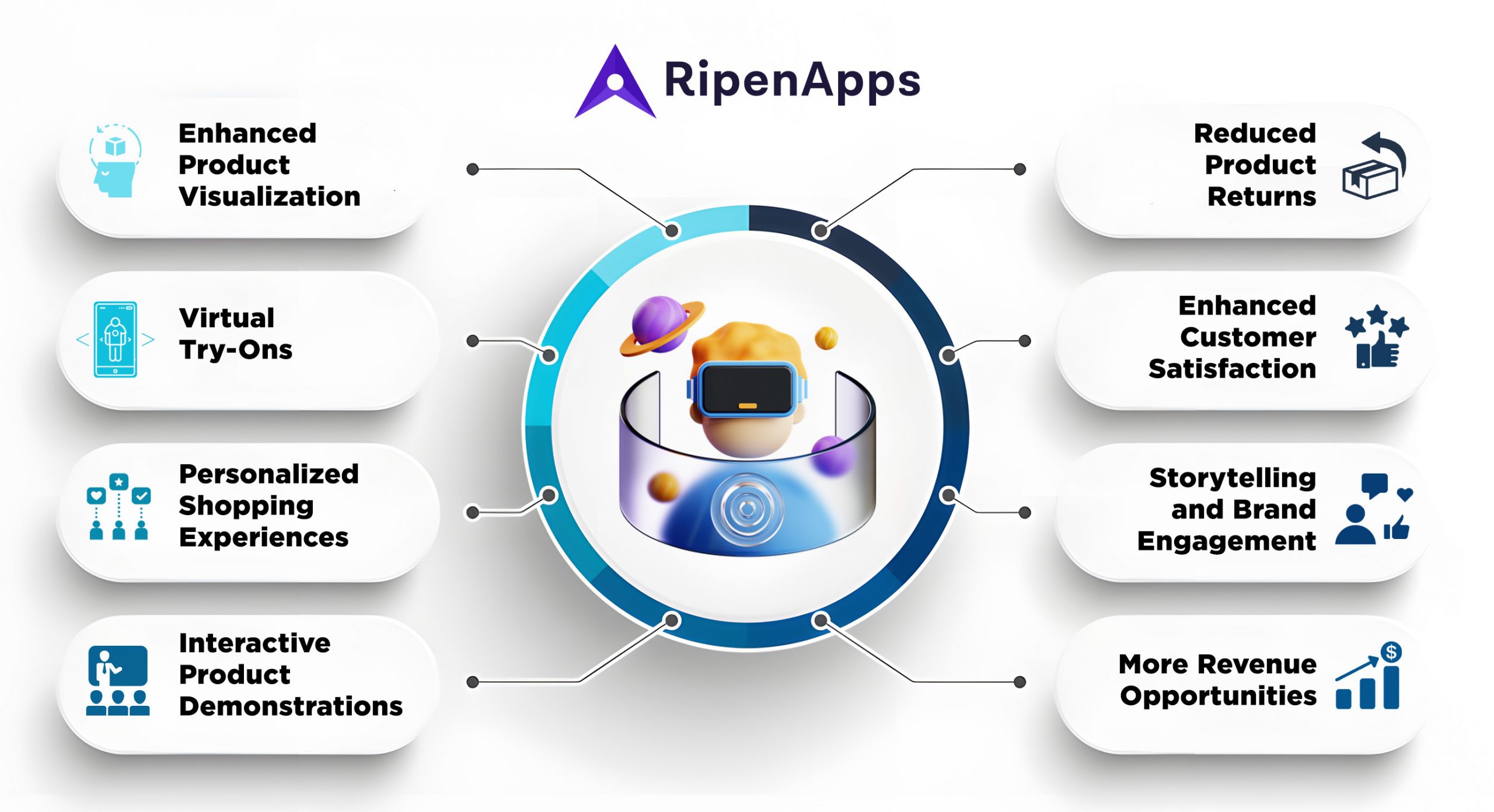
As we have seen above what current challenges do e-commerce businesses face in conversion ratio. Virtual reality technology here stands as the most powerful and effective tool that could help you not only improve conversion rate but also deliver a next-gen online shopping experience. Let us explore those ways through which virtual reality in ecommerce helps you increase conversion.
1. Enhanced Product Visualization
Virtual Reality offers consumers the ability to interact with products in three-dimensional space. It provides a level of immersion and precise detail that static images or videos cannot match. With VR features, users can rotate, zoom in, and examine products from various angles.
So, here VR enhances the visualization process and helps customers make more informed purchase decisions. This increased clarity and understanding of product features reduces uncertainty in product selection. Thus, it ultimately leads to higher conversion rates as customers feel more confident in their choices.
2. Virtual Try-Ons
It is among the top benefits of using virtual reality in eCommerce. This Virtual Try-On feature enhances the way customers shop for fashion, accessories, beauty, and other products. By simulating the process of trying on items virtually, users can see how products look and fit themselves in real-time.
They don’t need to visit a physical store. This feature addresses a major concern in today’s ecommerce industry– the inability to physically try on products. In the USA, top mobile app development company Dallas also suggests the growing demand for this feature.
With the virtual try-ons feature, ecommerce businesses can efficiently reduce the likelihood of product returns due to sizing or style issues. Many ecommerce businesses have already implemented virtual reality in mobile ecommerce apps to increase customer engagement and conversion rates.
3. Personalized Shopping Experiences
VR technology enables e-commerce platforms to create personalized shopping environments that are tailored to each customer’s preferences, browsing history, and behaviour. By analyzing data such as past purchases, search queries, and interactions, VR can help you curate e-commerce stores that resonate with individual users on a deeper level.
Such online shopping personalization not only enhances the relevance and appeal of product offerings. But also increases the likelihood of conversion as customers feel understood and catered to on an individual basis.
4. Interactive Product Demonstrations
This is also one of the top advantages of implementing virtual reality in ecommerce. VR facilitates interactive product demonstrations that allow customers to engage with products in virtual environments.
Whether it’s exploring the interior of a home, testing out the functionality of electronics, or experiencing the performance of a vehicle, interactive demonstrations provide a hands-on experience that goes beyond traditional product descriptions or videos. It helps you foster a sense of ownership and connection which ultimately contributes to an improved conversion ratio.
5. Reduced Product Returns
High product return is among the major problems which most ecommerce businesses face. And there are many considerable reasons behind high product returns. For instance, sizing discrepancies, color variations, or aesthetic preferences.
Many times, customers don’t get a proper idea of whether a product fits them or not. Conventional ecommerce apps or other platforms have limited options to help customers make the right product purchase. So, this ultimately results in product returns.
But here Virtual Reality helps reduce product returns by providing more accurate representations of products. With virtual try-on features, customers can visualize and interact with products in detail before making a purchase. Consequently, it results in reduced product returns and saves huge costs for e-commerce businesses.
6. Enhanced Customer Satisfaction
VR in ecommerce helps you enhance customer satisfaction by offering immersive, engaging, and personalized user experiences. VR technology helps create interactive demonstrations, virtual try-ons, and personalized recommendations.
Hence, with such top-notch features, e-commerce platforms can exceed customer expectations and provide a level of service that sets them apart from competitors.
This heightened level of satisfaction leads to greater customer loyalty, positive word-of-mouth referrals, and repeat purchases. And ultimately drive long-term success and growth.
7. Storytelling and Brand Engagement
Virtual Reality and Augmented Reality technology help you build an ecommerce app with powerful features for impactful storytelling and brand engagement. It empowers businesses to create immersive narratives that resonate with customers on an emotional level.
Apple Vision Pro is one of the best recent examples. Just see how their product page entices users with highly engaging VR features. By transporting users to captivating virtual environments, Apple’s Product Page showcases brand values and mission in an immersing way.
So you can also leverage virtual reality technology to foster a deeper connection between customers and brands. This emotional engagement not only strengthens brand loyalty but also drives conversions by inspiring trust among consumers.
8. More Revenue Opportunities
Virtual Reality opens new opportunities for cross-selling and upselling in ecommerce. You can strategically integrate virtual environments in your ecommerce application and offer personalized recommendations based on user interactions.
In addition to this, e-commerce platforms can also maximize the value of each transaction and increase average order sizes. So, by integrating Virtual reality technology in eCommerce you can drive better revenue growth and profitability for businesses.
Read Also: How is Augmented Reality Reshaping the Travel & Tourism Industry?
How to Implement Virtual Reality in eCommerce App?
Implementing Virtual Reality (VR) in e-commerce requires careful planning, UI/UX design, and integration of AR/VR technology as per industry verticals. Its deployment depends on several factors such as the type of ecommerce app, mobile platform, tech stacks, and so on.
Since virtual reality in ecommerce is in the evolutionary stage you might need consultation from an expert ecommerce mobile app development companies to successfully integrate VR capabilities in your ecommerce app or platform.
Being a professional mobile app development company, we know what VR-based eCommerce apps require. So here we have shown the crucial steps that you must follow while implementing VR in eCommerce app.
- Define Your VR Goals: Understand and clearly define the goals and objectives of integrating VR into the e-commerce app.
- Identity User Problems: Identify target users and their preferences to determine which VR features would provide the most value.
- Choose the Right VR Platform: Select a VR platform and hardware devices that align with the app’s target audience and technical requirements.
- Create VR Content: Develop immersive VR content tailored to your e-commerce app’s product offerings and user experience goals. This may include 3D product models, virtual showrooms, interactive product demonstrations, or virtual try-on experiences.
- Integrate VR Functionality into the App: Implement VR features such as navigation controls, interactive elements, and gesture recognition to enhance the immersive experience. This process will be done by an AR VR app development company.
- Optimize Performance and Compatibility: Optimize VR content and graphics for better performance and compatibility with various VR devices and mobile platforms.
- Promote and Market the VR Experience: Showcase VR content, demos, or testimonials to entice users to explore the immersive experience.
Top Examples of Virtual Reality in Ecommerce Apps That Witnessed Better Conversions

There are several e-commerce companies that have successfully integrated Virtual Reality (VR) into their apps to drive business growth. These examples demonstrate how e-commerce companies can leverage AR/VR technologies to create immersive, engaging, and personalized shopping experiences that drive customer satisfaction and business success.
1. IKEA Place
IKEA Place is one of the famous ecommerce apps that successfully uses augmented and virtual reality. This app allows users to visualize how furniture and home decor items would look in their own homes through the use of AR technology. By providing an immersive shopping experience IKEA significantly improved their growth which contributed to higher conversion rates.
2. Lowe’s Holoroom
Lowe’s is a leading home improvement retailer brand. This company introduced the Holoroom VR experience in select stores to let their customers design and visualize their renovation projects in virtual reality.
The Holoroom VR experience helped Lowe’s customers make more informed decisions about home improvement projects, which ultimately resulted in better sales and customer satisfaction.
3. ASOS Virtual Catwalk
ASOS, a popular online fashion retailer, launched a Virtual Catwalk feature on its app to let users experience fashion shows in virtual reality. Through the app, users can explore 360-degree views of models walking down the runway, showcasing the latest clothing collections in immersive detail.
The Virtual Catwalk feature has helped ASOS customers visualize how clothes fit and move in real-life. And thus increased confidence in purchasing fashion items online.
4. Amazon AR View
The world’s iconic ecommerce brand never stays behind when it comes to adopting emerging technology. The e-commerce giant has already introduced its exclusive Amazon’s AR View feature. With the AR View feature in the Amazon app, customers can see how furniture, electronics, and other products would look in their living space before buying. After implementing this feature, Amazon has enhanced customer engagement and conversion rates.
Wrapping Up
Virtual reality is a powerful and innovative technology. It enables ecommerce applications with advanced capabilities to offer immersive user experience in online shopping. Today, eCommerce businesses need smart and effective solutions to make their buying journey and conversion process more engaging and productive. In this case, virtual reality in ecommerce stands as the best technology solution that empowers ecommerce businesses to increase the conversation ratio and deliver a next-level user experience. However, the integration of VR in ecommerce apps requires great technical expertise. So it is advisable to get assistance from a dedicated ecommerce app development company that specializes in developing VR-based ecommerce app solutions.


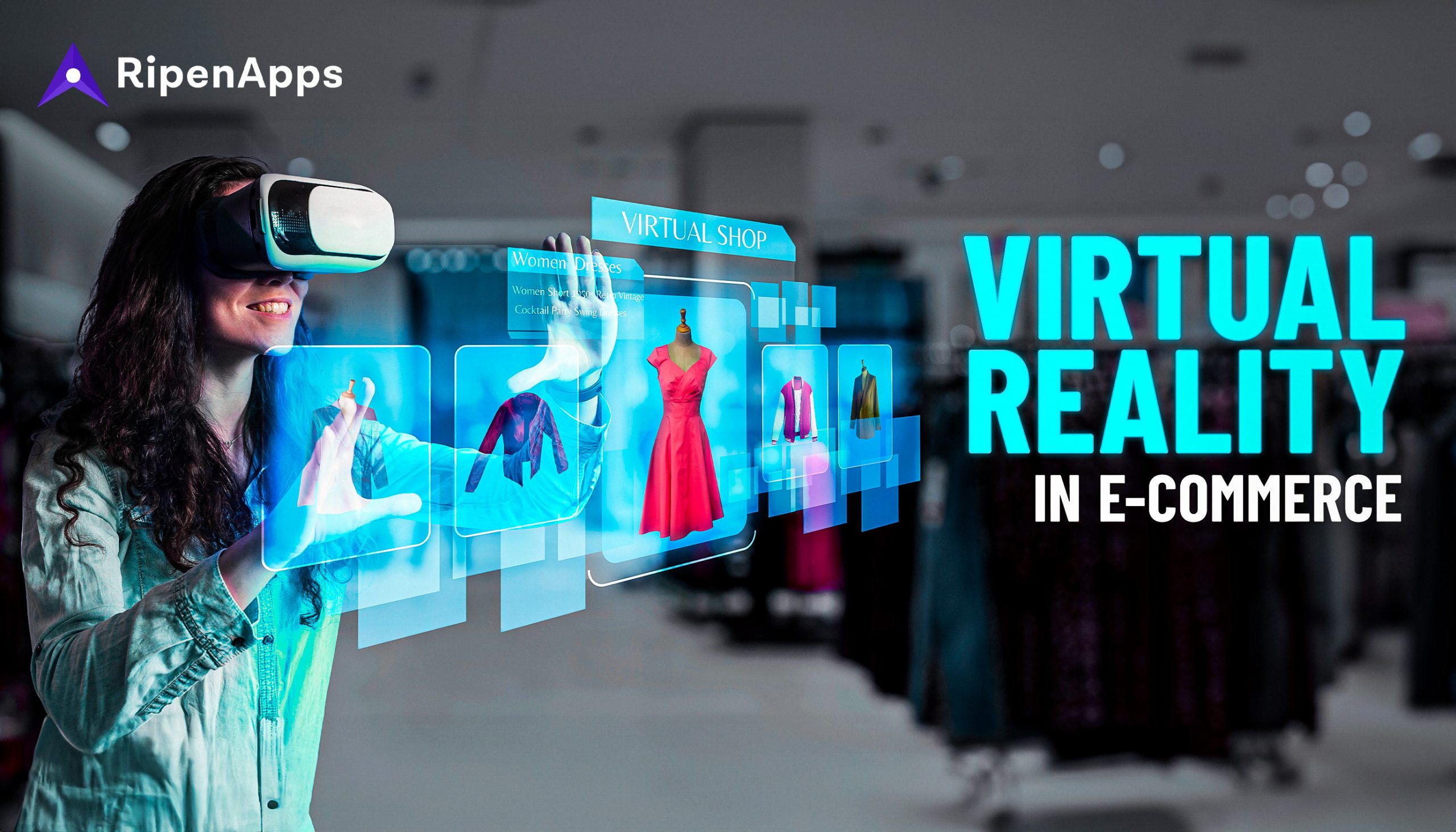




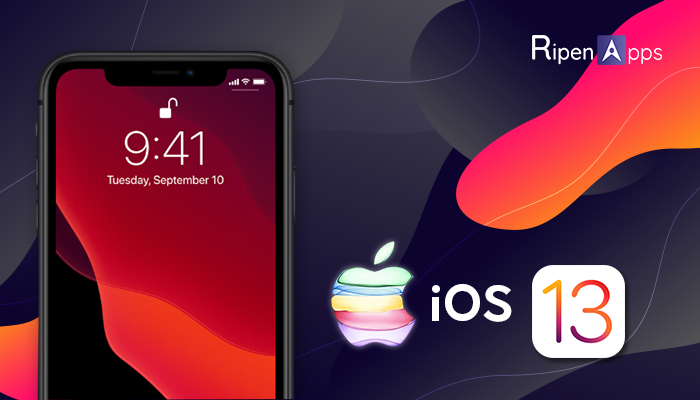
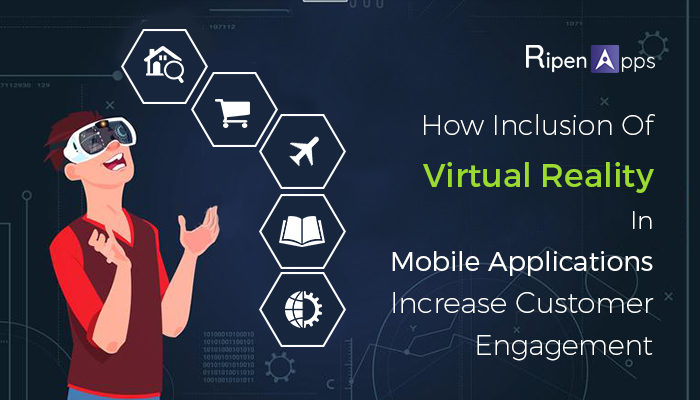

 India
India USA
USA Australia
Australia Canada
Canada UK
UK UAE
UAE